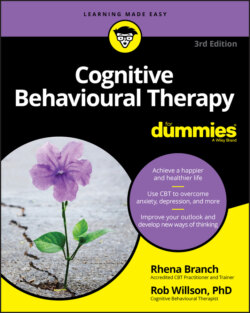Читать книгу Cognitive Behavioural Therapy For Dummies - Rob Willson - Страница 72
Tolerating upsetting images and unpleasant ideas
ОглавлениеCertain psychological problems such as depression and anxiety disorders like OCD are frequently accompanied by unwelcome, unsettling images or thoughts. Depressed people can have ideas about harming themselves or even get strong visual images of doing so – even when they’ve no real intention of taking suicidal action. These thoughts are understandably very distressing and people may worry that they indicate a real risk. Happily this is not often the case; most of these thoughts are merely an unpleasant by-product of depressed mood. It’s easy to misinterpret these images and thoughts as dangerous or portentous but learning to see them as what they really are – just unpleasant symptoms of depression or anxiety – can render them less frightening.
Not all suicidal ideas are to be ignored. If you find yourself becoming increasingly preoccupied with ideas of harming yourself or ending your life, seek help immediately. This advice is especially important if you’ve begun to develop a plan and find your suicidal thoughts comforting. Talk to your doctor, a family member or friend or take yourself to the psychiatric emergency unit at your nearest hospital. Chapter 12 deals with depression. You can also read Chapter 23 for valuable information about seeking professional help.
People with OCD (more on this disorder in Chapter 14) often experience intrusive thoughts and images. The content of these thoughts and mental pictures can vary widely, but they’re frequently about harming people you love or acting in a way that dramatically violates your moral code. Other emotional or anxiety problems can also give rise to a host of nightmarish ideas and images. Some classics may include the following:
Losing control of your bladder or bowels in public
Blurting out something really offensive
Behaving in a sexually inappropriate manner
Jumping on to a train track
Driving your car recklessly
Harming an animal
Harming yourself or another person (a child or loved one)
Having a panic attack in a public place
Making a bad decision which results in irreparable consequences
Being harshly rejected or humiliated
Experiencing thoughts and images about death or violence (to self and others)
When you have such unsolicited ghoulish mental activity, it’s very understandable that you want to get rid of it. Typically however, the harder you try to rid yourself of such thoughts and images, the more they take hold. This is because your attempts to eliminate, avoid or neutralise unwelcome thoughts are driven by the fundamental rule:
‘I must not have such thoughts; they’re unacceptable and mean something dreadful.’
When you put effort into preventing or eliminating a certain thought, you’re inadvertently focusing more attention on it. If you regard certain kinds of mental activity as taboo, then you increase your fears of it occurring. Paradoxically, you may end up increasing the frequency of intrusive images and thoughts plus elevating your disturbance in response to them. Everyone has intrusive thoughts and images from time to time. Even if you’re not in any form of psychological or emotional distress, you’re not immune to the occasional gruesome mental image. People without anxiety or depression, however, are more readily able to dismiss the thought or image as unpleasant (or even shocking) but of ultimately no real importance. You can begin to tolerate unpleasant thoughts by adopting the following attitude:
‘I don’t like these thoughts, but they aren’t abnormal or important. They don’t mean something bad about me.’
